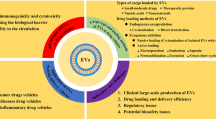Abstract
The incorporation of drugs into vesicles is one of several technological methods for the optimization of targeted drug delivery and controlled drug targeting. The main problems will always remain
-
• To design inert auxiliary accompanying materials in order to overcome side reactions
-
• To use body-friendly and biodegradable macromolecular carrier materials for the therapeutic system
-
• To miniaturize the dosage form dramatically in the submicroscopic size range in order to eliminate foreign body irritations
-
• To develop ultrafine solid and amorphous vesicular compartments (nanocapsules, nanopellets, nanoparticles) to get stable systems with good tissue transfer and organ targeting properties
The actual stand of the incorporation of drugs and biologic active material into ultrafine colloidal solid capsules is reviewed here as for instance:
-
• Immunoactive material
-
• Fluorescent indicators in body fluids
-
• Controlled and sustained release systems
-
• Nonspecific drug targeting of the first-order (passage through endothelial tissues)
-
• Second-order targeting (a specific transparenchymal migration), and a highly specific targeting of the third-order (transcellular passage, especially lysosomal transports)
Examples for some of these applications are given.
It can be shown that such ultrafine vesiculated capsules offer some advantages when applied parenterally, but also partly for oral application. In the future, still more studies are necessary finally to clarify the importance and practical use of such ultrafine targeting carriers.
Similar content being viewed by others
References
Speiser, P. (1979), inLysosomes in Applied Biology and Therapeutics,6, Dingle, J. T., Jacques, P. J., and Shaw, I. H., eds., North Holland, Amsterdam.
Kreuter, J., Täuber, U., and Volker, I. (1979),J. Pharm. Sci. 68, 1443.
Nowinsky, W. W. (1958),Fundamental Aspects of Normal and malignant Growth, Elsevier, Amsterdam.
Nicholson, D. E. (1968),Metabilic Pathways, Koch-Light Lab., Colnbrook, Bucks, England.
Pantucek, M. (1969),FEBS Lett. 2, 206.
Kante, B., Couvreur, P., Dubois-Krack, G., DeMeester, C., Guiot, P., Roland, M., Mercier, M., and Speiser, P. (1982),J. Pharm. Sci.,71, 786.
Lübbers, D. W., Opitz, N., Speiser, P., and Bisson, H. (1979),Z. Naturforsch,32c, 133.
Speiser, P. (1979),Lysosomes in Applied Biology and Therapeutics 6, Dingle, J. T., Jacques, P. J., and Shaw, I. H., North Holland, Amsterdam.
Kreuter, J., and Speiser, P. (1976),Infect. Immun. 13, 204.
Kreuter, J., and Speiser, P. (1976),J. Pharm. Sci.,65, 1624.
Volkheimer, G., (1977),Adv. Pharmacol. Chemotherapy 14, 163.
Nefzger-Biessels, M., personal communication.
Brasseur, F., Couvreur, P., Kante, B., Roland, M., Deckers, C., Speiser, P., and Deckers-Passau, L. (1982).J. Pharm. Sci.,71, 790.
DeDuve, C., deBarsy, Th., Trouet, A., Tulkens, P., and vanHoof, F. (1972).Biochem. Pharmacol. 23, 2495.
Trouet, A., Jadin, J. M., and vanHoof, F. (1976), inBiochemistry and Host Parasites Relationship, Elsevier, Amsterdam.
Trouet, A., Deprez de Campeneere, D., and deDuve, C. (1972),Nature New Biol.,239, 110.
Trouet, A., and Deprez de Campeneere, D. (1972),Nature New Biol.,239, 110.
Levy, R., Hurwitz, E., Maron, R., Aron, R., and Sela, M. (1975),Cancer Res. 35, 1182.
Segal, A. W., and Willis, E. J. (1974),Exp. Pathol. 55, 320.
Gregoriadis, G., and Neerung, D. Jr. (1974);Eur. J. Biochem. 47, 179.
Rhaman, Y. E., Kisielsky, W. E., Brass, E. M. and Cerny, E. A. (1975),Eur. J. Cancer 11, 883.
DeBarsy, Th., Devos, P., and vanHoof, F. (1976),Lab. Invest. 34, 273.
Couvreur, P., Tulkens, M., Roland, M., Trouet, A., and Speiser, P. (1977).FEBS Lett. 84, 323.
Tulkens, M., Beaufay, H., and Trouet, A. (1974),J. Cell. Biol. 63, 383.
Author information
Authors and Affiliations
Rights and permissions
About this article
Cite this article
Speiser, P. Drug targeting by drug entrapment into ultrafine compartments as carriers. Appl Biochem Biotechnol 10, 221–235 (1984). https://doi.org/10.1007/BF02783754
Received:
Accepted:
Issue Date:
DOI: https://doi.org/10.1007/BF02783754




